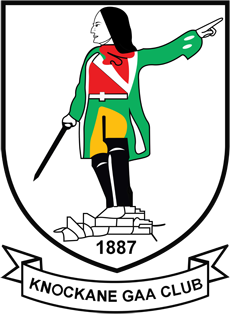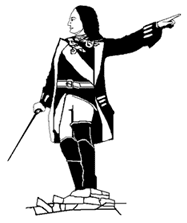 Sarsfield’s Rock & Ballyneety
Sarsfield’s Rock & Ballyneety
*Article taken from http://indigo.ie/~wildgees/
After the defeat of the Jacobites at the Battle of the Boyne (1-7-1690 ) James II fled to France, and the remnants of the Irish army, under Lauzun, Tyreconnel, Sarsfield and Berwick retreated to Limerick. They were pursued by William, who entered Dublin in triumph and captured Clonmel, Kilkenny and Waterford on the way south. Limerick was the most important stronghold in the southern provinces, and was mainly Catholic in population.
As news of his approach reached Limerick, acrimonious disagreements broke out amongst the Limerick garrison. Lauzun, who commanded, was for evacuation and surrender, and he was supported by Tyreconnel in his arguments. Sarsfield maintained that the city could be held, and he was supported by the young Duke of Berwick. Lauzun’s excuse for withdrawing from Limerick was that the city was not tenable and that it “could be taken with roasted apples”. Sarsfield and the Irish Jacobites boldly declared that they would not submit, and said that they would defend the city themselves. Tyreconnel and Lauzun decided to remove themselves to Galway for transportation to France. They appointed General Boisseleau Governor of the city, but removed all the French troops, their cannon and equipment with them. The whole of the Irish army, numbering about 15,000 remained to defend Limerick under Boisseleau and Sarsfield.
The news of the departure of the French elated the Williamites, who now considered Limerick a push over, and were sure of abject surrender on their terms. William marched on several days ahead of his cannon, ammunition and provisions. Thus he was without the full equipment which was essential for a siege, and which was on a siege train which followed from Dublin at a more leisurely pace. On the 7th of August 1690 the Williamite army of about 40,000 camped at Caherconlish, about seven miles south-east of Limerick. The Jacobites in the city were puzzled as to why William was not commencing the siege. A deserter from the enemy provided the answer. He informed them that the Dutch general was waiting for the siege train which was on its way, and was presently approaching Cashel on August 10th. Sarsfield was among those who interrogated the deserter, and a daring plan began to form in his mind.
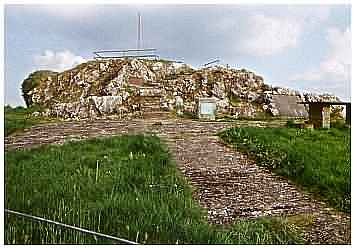 On Sunday night August 10th 1690, under cover of darkness, Sarsfield rode out of Limerick with a company of six hundred picked riders. With their horse-hooves muffled, they rode silently out of Limerick on the north side, and continued through Co. Clare, where they crossed the Shannon at Killaloe. They crossed over into the Silvermines Mountains and when dawn appeared they camped in the valley of Keeper Hill. They were guided by Galloping Hogan, who was the leader of the famous Wild Rapparees, in this expedition. He knew every inch of the countryside between Cashel and Limerick, and his services were invaluable on that night. On the slopes of Keeper Hill they were clearly drawing closer to the siege train, and extreme caution was necessary lest they would be betrayed. Luck was on their side, and every person encountered proved a valuable source of information. With extreme caution Sarsfield drew nearer and nearer to the advancing siege train. They found that the convoy was guarded by one hundred soldiers only. Confident that they would not be attacked, the convoy halted for the night at Ballyneety, a little place south-east of Limerick and only ten miles from Williams camp. Drawing up their wagons near a ruined castle, they turned the horses to graze, and leaving only five or six on guard duty, the escort turned in for the night. The guards also fell asleep. This was Monday night August 11th.
On Sunday night August 10th 1690, under cover of darkness, Sarsfield rode out of Limerick with a company of six hundred picked riders. With their horse-hooves muffled, they rode silently out of Limerick on the north side, and continued through Co. Clare, where they crossed the Shannon at Killaloe. They crossed over into the Silvermines Mountains and when dawn appeared they camped in the valley of Keeper Hill. They were guided by Galloping Hogan, who was the leader of the famous Wild Rapparees, in this expedition. He knew every inch of the countryside between Cashel and Limerick, and his services were invaluable on that night. On the slopes of Keeper Hill they were clearly drawing closer to the siege train, and extreme caution was necessary lest they would be betrayed. Luck was on their side, and every person encountered proved a valuable source of information. With extreme caution Sarsfield drew nearer and nearer to the advancing siege train. They found that the convoy was guarded by one hundred soldiers only. Confident that they would not be attacked, the convoy halted for the night at Ballyneety, a little place south-east of Limerick and only ten miles from Williams camp. Drawing up their wagons near a ruined castle, they turned the horses to graze, and leaving only five or six on guard duty, the escort turned in for the night. The guards also fell asleep. This was Monday night August 11th.
In the meantime, however, a spy had brought news of Sarsfields movements to William’s camp. He had seen the Irish dragoons moving through the mountains and hastily brought the news to the enemy. No one took much notice of this news, as it was commonplace to have frequent movement of troops, and it was considered that the spy was trying to secure his own position with the Williamites. The King chanced to hear it and at once guessed what Sarsfield was up to. He ordered a detachment to leave the camp at nine o’clock that night to meet the convoy and protect it on the last stage of its journey.
But the luck of the Irish was with Sarsfield on this mission. In the evening one of his soldiers horses cast a shoe, and he was obliged to fall behind and walk the animal. He met with a woman on her way to Ballyneety, and they became engrossed in conversation. She told him that she was the wife of a Williamite soldier and that she was on her way to Ballyneety to rejoin her husband, who was one of the escort of the siege train. She told him that the password for the night was Sarsfield.
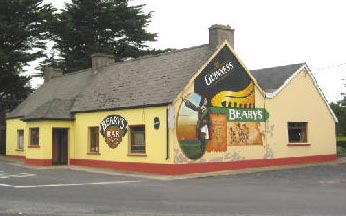 The Irish soldiers gradually closed in on the siege train, and in single file approached the sentry. The first was allowed to pass after giving the correct password, and Sarsfield came next. Legend has it that he answered the challenge with a delighted roar: Sarsfield’s the word and Sarsfield’s the man. Too late the escort realised their danger, and over half were killed, the rest fled and one officer was taken prisoner. The Irish rounded up about five hundred horses, which were already saddled and bridled and with pistols in the saddles. The siege train itself exceeded all expectations. It comprised of one hundred and fifty-five wagons of stores, mainly ammunition for the military; six twenty-four pounder cannons; two eighteen pounders; five mortars; eighteen pontoons, and twelve wagons of biscuit and other provisions.
The Irish soldiers gradually closed in on the siege train, and in single file approached the sentry. The first was allowed to pass after giving the correct password, and Sarsfield came next. Legend has it that he answered the challenge with a delighted roar: Sarsfield’s the word and Sarsfield’s the man. Too late the escort realised their danger, and over half were killed, the rest fled and one officer was taken prisoner. The Irish rounded up about five hundred horses, which were already saddled and bridled and with pistols in the saddles. The siege train itself exceeded all expectations. It comprised of one hundred and fifty-five wagons of stores, mainly ammunition for the military; six twenty-four pounder cannons; two eighteen pounders; five mortars; eighteen pontoons, and twelve wagons of biscuit and other provisions.
All the wagons were dragged on top of one another. The siege guns were filled with powder, and their muzzles were rammed deep into the ground. The casks and pontoons and ammunitions were flung up on top of this pile. A short trail of gunpowder was laid and ignited, and the Irish soldiers made haste their escape. There was a flash that lighted all the heavens, and the ground rocked and heaved, and with a deafening roar the vast mass burst into the sky.
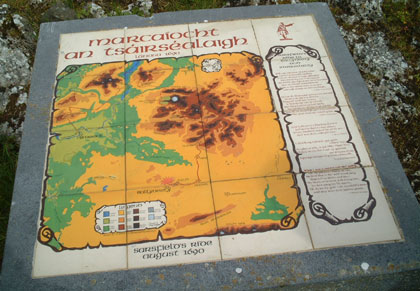
The ammunition exploded with a blinding flash, and the pile burned steadily. William’s siege train was a pile of shattered wreckage. Luck was still on the Irish side. The Dutch company, that was ordered out to protect the convoy, did not leave Limerick at the appointed time of nine o’clock, but delayed its departure until after midnight. They were only about a mile from Ballyneety when the explosion occurred. Furiously rushing to the scene of the explosion they found that the Jacobites had fled. They arrived just in time to be too late. They followed for some distance, but believing capture impossible, they wheeled westward trying to cut off Sarsfield before he reached the Shannon. Darkness favoured the Irish, and with Galloping Hogan as their guide they safely crossed the Shannon at Portumna on the 14th August. The pursuers gave up the chase, and with their tails between their legs they returned to their camp in Limerick. Sarsfield was now in familiar territory, as he was in his brother-in-laws estate in Portumna. He made his way easily back to Limerick, where he received a rapturous welcome. Pride in his daring move revived the flagging spirits of the garrison in Limerick, and they now prepared themselves for a stout resistance.
The exploit at Ballyneety saved Limerick. It took William a whole week to replace the equipment that had been destroyed, and it gave the Irish time to regroup, whilst awaiting news of reinforcements from France, and it brought nearer the rainy season which favoured the Irish.
William began his siege of Limerick on 17th August 1690, but after massive resistance by the garrison and the people of Limerick, the siege was lifted on the 30th of August, and William sailed out of Ireland immediately for England, leaving Ginkel in charge. He sent over also that renowned general, Churchill, Duke of Marlborough, who was an uncle to the Duke of Berwick.
Tradition has preserved the route of Sarsfield’s Ride. He rode first to Glennagross and then down to Ballyvalley ford outside Killaloe where he crossed the river, and then inland to Labadiha Bridge (also known as Hogan’s Glen). He then made his way into the wooded Silvermine mountains, along the west side of Keeper Hill through Ballyhourigan Wood and then up the valley to Toor and between the hills to Rearcross. Mother Mountain and the Bilboa river valley are next encountered, and then on to Glengar. After dark on the 11th of August, Sarsfield’s men crossed the low country to Toem, Monard and Cullen, and from there they moved quickly to Derk, and thence one mile on to Ballyneety. A memorial on the site of the battle was unveiled by the then President of Ireland, Cearbhall O’Dalaigh on August 8th 1976.
Monument at the Entrance to Sarsfield’s Rock
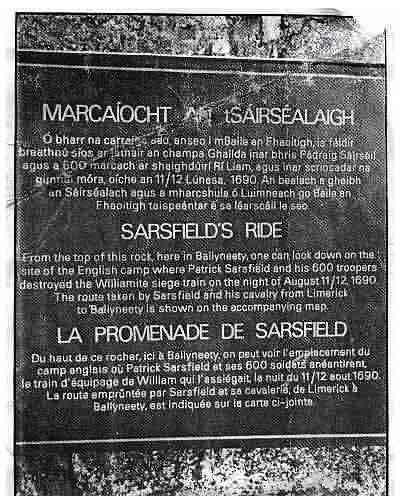 Song of Sarsfield’s Trooper
Song of Sarsfield’s Trooper
The night fell dark on Limerick and all the land was still,
As for the foe in ambush we lay beside the hill;
Long impatiently we waited to rush upon our prey,
With noble Sarsfield at our head before the break of day.
From Dublin came foemen, with deadly warlike store –
Huge guns with tons of powder and thund’ring balls galore
But little was he dreaming that there to work his bale,
We’d come with our commander bold from dark Slieve Felims Vale.
At the lonely hour of midnight each man leaped on his stead,
Down moor and vale to Cullen we dashed with lightening speed;
Then eagerly we galloped to Ballyneety’s wall,
Where lay our foe’s encampment with guns and stores and all.
“Give the word!” – “The word is Sarsfield, and Sarsfield is the man:
And here I am!” our general cried, as down on them we ran;
Then God he cleared the firmament, the moon and stars gave light,
And for the battle of the Boyne we took revenge that night.
From a book by Robert Dwyer-Joyce
Bibliography
Patrick Sarsfield and the Williamite War, Piers Wauchope, 1992.
The Wild Geese, Maurice N. Hennessy.
Patrick Sarsfield, Alice Curtayne, 1934.
Sarsfield’s Ride, Eamonn De Stafort.
The Story of Ireland, A. M. Sullivan, 1867.
We Must Find a Future for our Past, Michael Nash, Patrick Hogan, Michael McInerny of the Ballyneety 300 Committee.
Copyright ©2000, Sean Ryan
Update: 2005
Access to the historic site of Patrick Sarsfield’s destruction of the Williamite siege train at Ballyneety in August 1690 has been enhanced by the provision of improved roadside parking facilities. Limerick County Council has invested €25,000 in the project in an attempt to attract more tourists to visit Sarsfield’s Rock and enjoy the magnificent vista of the surrounding countryside from its summit.
